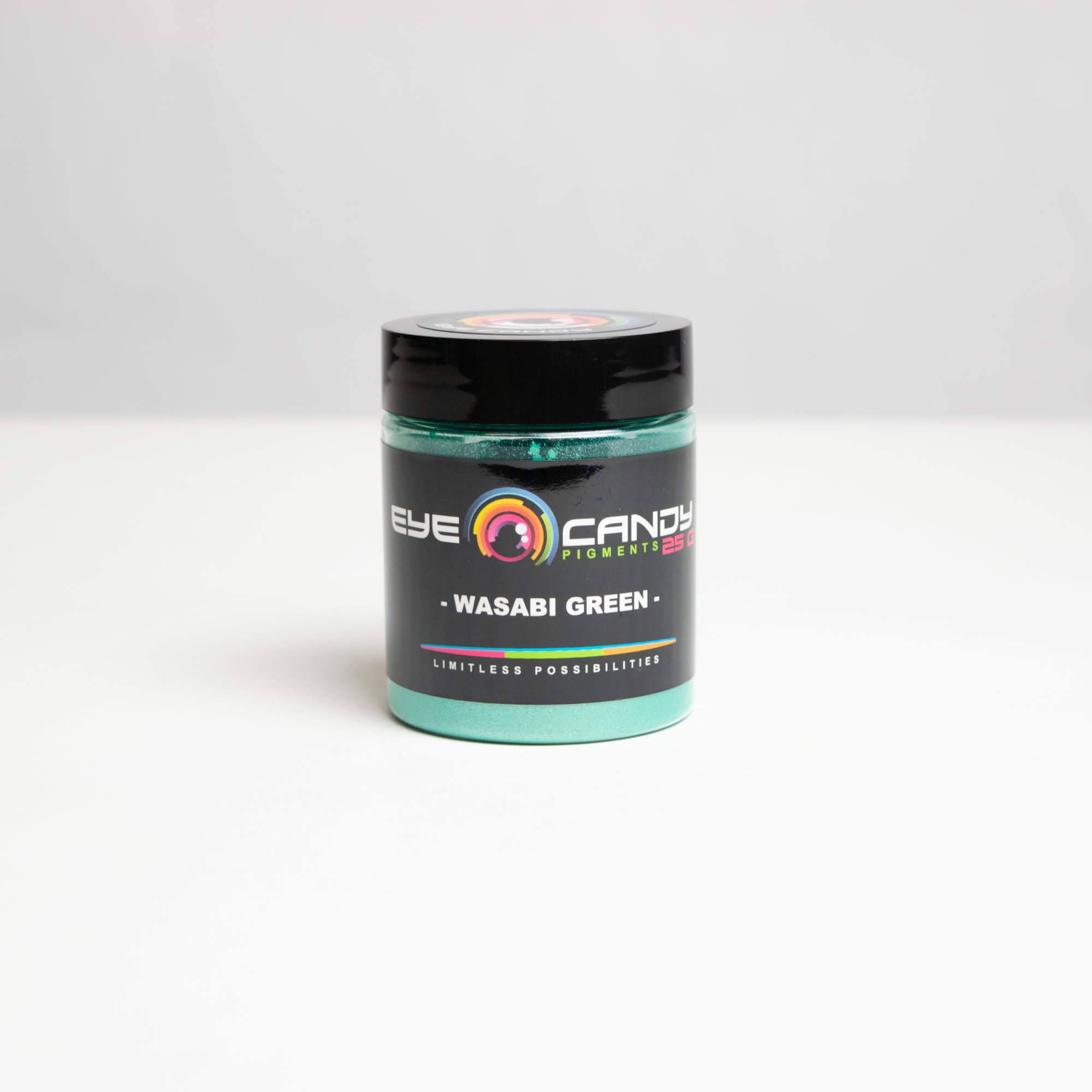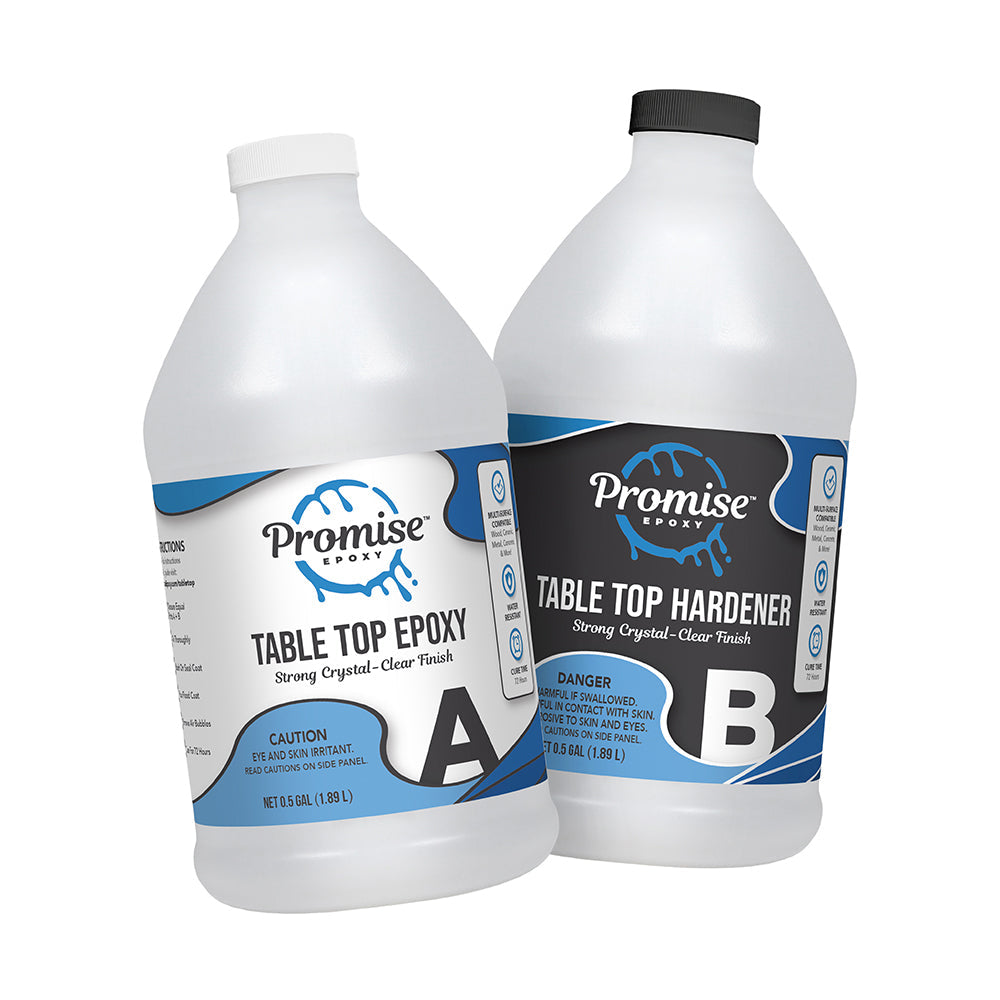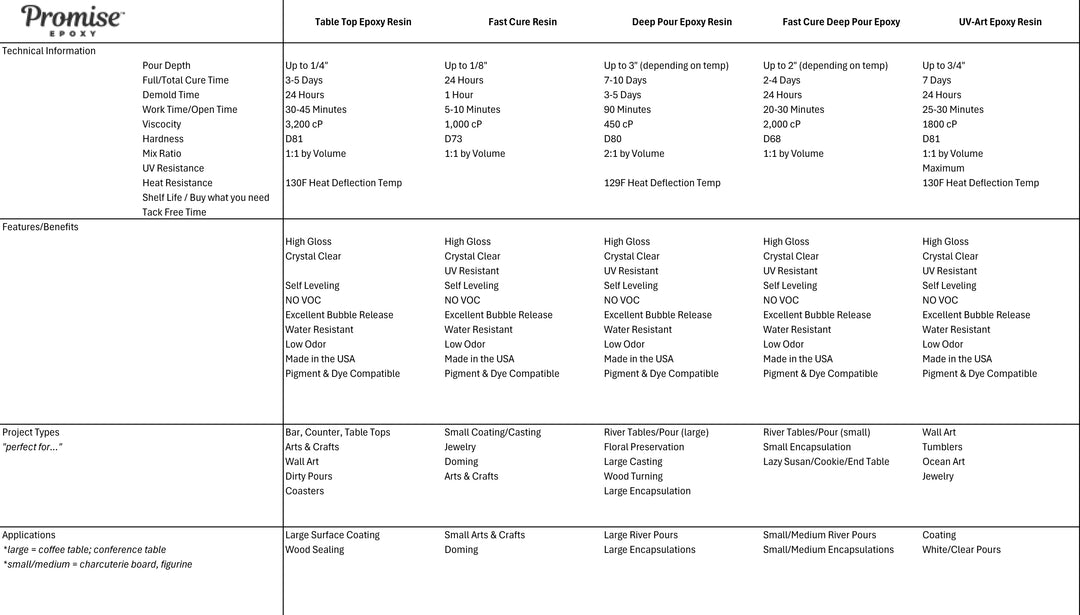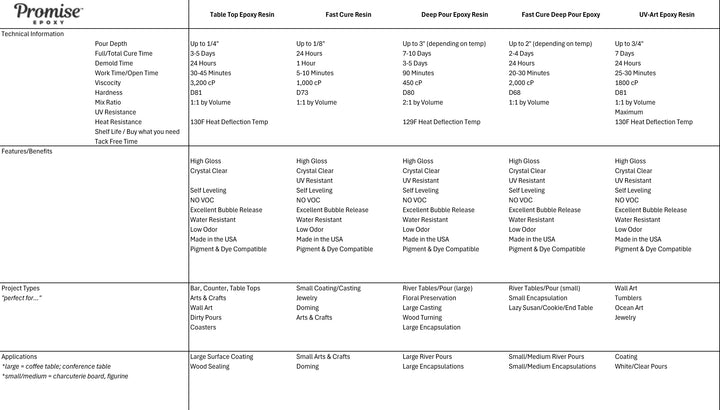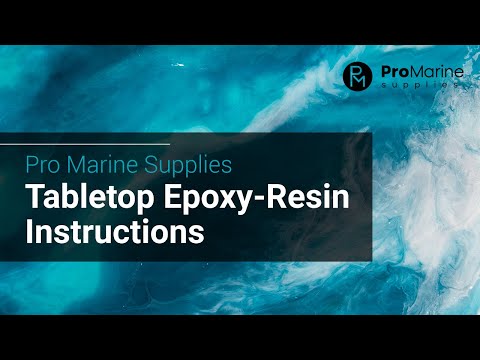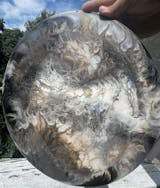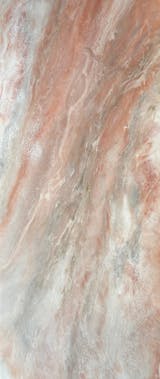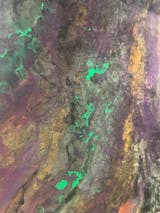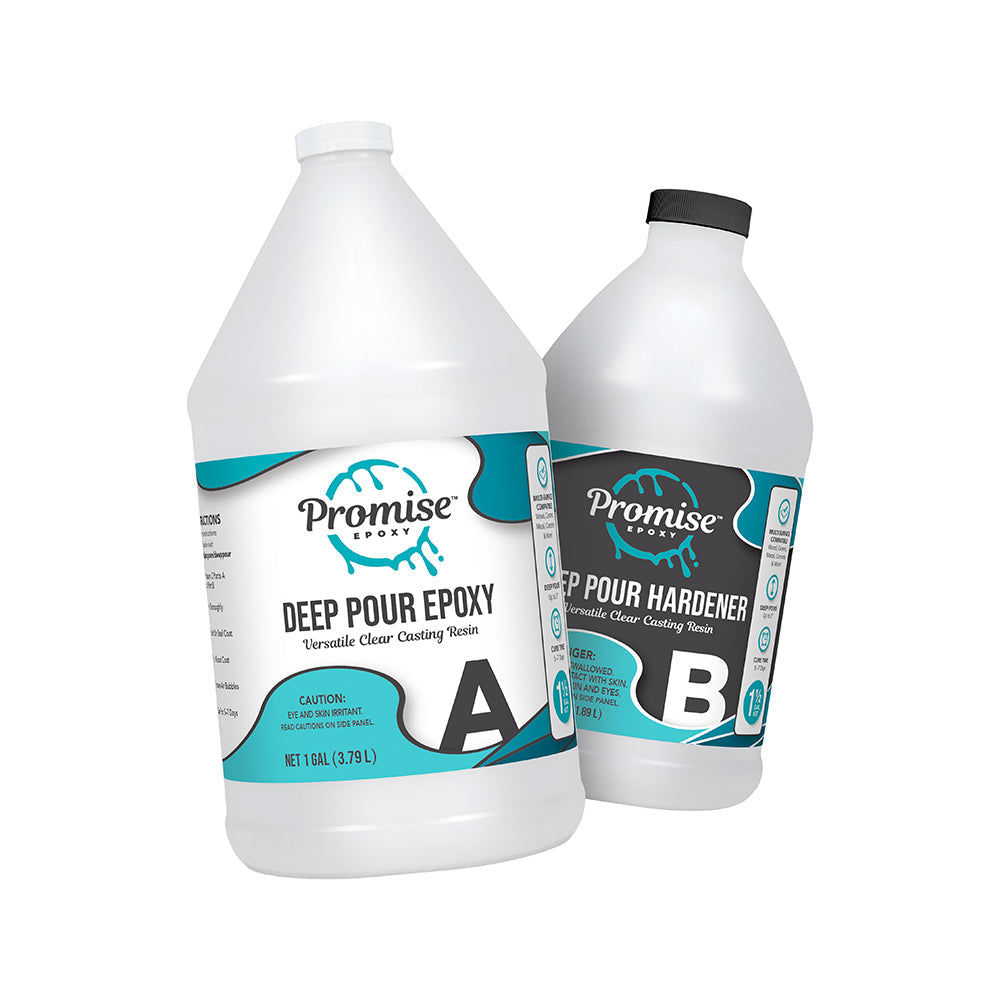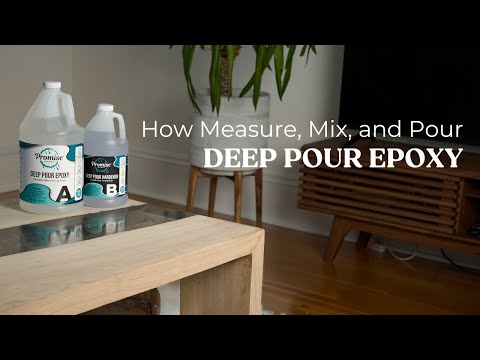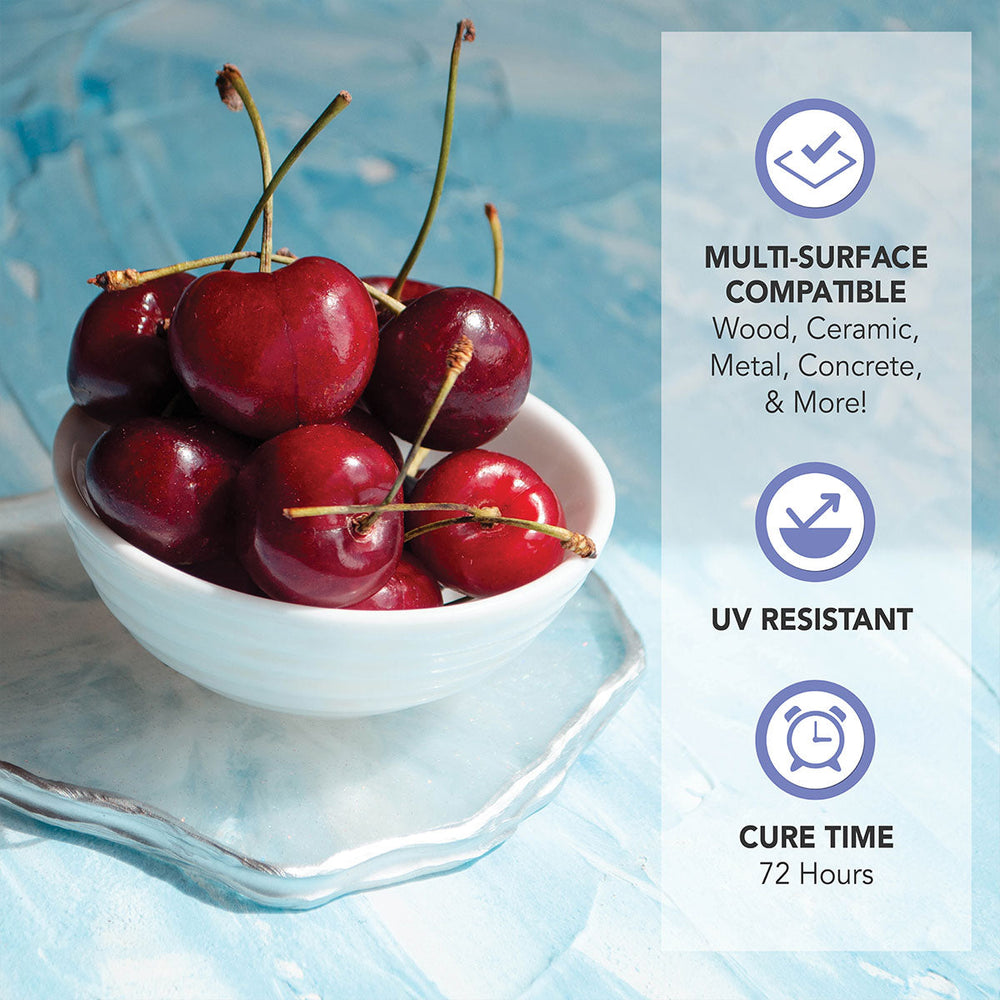Promise Table Top Epoxy Resin: The Ultimate Solution for Every Epoxy Resin Art Maker and DIY Enthusiast
Transform your creative projects to the highest-quality with Promise Table Top Epoxy Resin. This versatile, crystal-clear epoxy resin is designed to meet the needs of artists, DIYers, and home decorators alike. Its user-friendly mix ratio, multi-surface capabilities, and water-resistant properties make it the perfect choice for creating stunning, custom table tops and more.
Features, Benefits & Specifications of Our Table Top Epoxy Resin
1:1 Mixing Ratio:
The straightforward 1:1 mixing ratio and simple application process make this epoxy resin perfect for beginners and experienced DIYers alike. The curing process for our table top epoxy is 72 hours. Our Promise Table Top Epoxy Resin ensures the most accurate and easy-to-understand mixing process, making it perfect for beginners and experts alike.
Water, Blush, and Impact-resistant:
Protect your art and home décor projects from moisture damage thanks to the water-resistant properties of our epoxy resin. This epoxy resin is designed to withstand everyday wear and tear, ensuring your projects remain in pristine condition.
Self-leveling:
Ditch the frustration of inconsistent pours with our easy-to-use, self-leveling epoxy resin for a smooth surface on bar tops, tables, and tons of other projects. Achieve a professional, high-gloss finish with ease as the resin self-levels, resulting in a smooth surface.
High-gloss Finish:
Our table top epoxy ensures a crystal-clear finish, allowing your creative vision to shine through. Add a touch of elegance to your projects with our epoxy resin's high-gloss finish.
Food Safe per FDA Code 300:
Our epoxy resin is safe to use on surfaces that come into contact with food, making it perfect for table tops and other kitchen projects.
Improved Surface Appearance:
Reduce imperfections and achieve a flawless finish with the help of our epoxy resin's advanced formula. Unleash your creativity on a variety of surfaces, including wood, concrete, metal, and more to get that crystal clear finish.
Eliminates Craters, Crawling, and Fish Eyes:
No more worrying about unsightly flaws in your projects thanks to our epoxy resin's ability to eliminate common issues. One important note on this feature; epoxy can NOT be poured over oil based paints and stain. Oil-based products and epoxy do NOT mix.
Compatible with Pigments and Dyes:
Get creative with your color choices by mixing this versatile epoxy resin with mica powder, pigments, and dyes. Options are endless in terms of color, glitter & sparkle.
What Can You Do for Even More Crystal Clear Results?
Wondering how to polish resin? The perfect pair for the best finished results is our Promise Pro Polish & Cleaner. The kit includes instructions on how to properly sand down your project and apply the polish and cleaner for a gorgeous finish.
Need More Info on How to Epoxy a Table Top?
If this is your first time using a resin and hardener? There are probably a ton of questions like:
How much resin should I use?
How time consuming will this project be?
What is the best practice for my environment?
Do I need a heat gun? How can I get rid of air bubbles?
What surface or counter tops can I use with a resin and hardener to build the best epoxy tables?
We've got you covered. Each table top epoxy kit comes with clear instructions to help guide you through the process. You can also check out our FAQ page for detailed questions and answers. You can also check out our epoxy calculator resource to find the perfect amount for your epoxy project.
Are You a Past ProMarine Supplies or Incredible Solution User?
Promise Epoxy uses the same resin and hardener as ProMarine for its table top epoxy. The merger of ProMarine and Incredible Solutions took the best of each product line like ProMarine's Table Top and Incredible Solutions Pourable Plastic, UV Art, & Polish and Cleaner.
Notes: All epoxy has natural color variations or tint and the color of the substrate the epoxy is applied to may accentuate this effect as well. White surfaces are always the most challenging to work with regarding epoxy tint. After all, "white" itself has multiple tints. The appearance of a white surface coated with epoxy is also influenced by lighting. For instance, there may be a dramatic aesthetic difference between LED "daylight" bulb lighting compared to "Soft/Warm" lighting.
This product is not intended for outdoor use.
Your ideas. our support.
At Promise Epoxy, we're not just committed to delivering quality products; we're dedicated to fostering a community of creativity and collaboration.
We believe in inclusivity and the power of shared ideas. Whether you're embarking on an exciting project and need some guidance on the best epoxy products to use, or you're looking to expand your small business or personal brand through a partnership with us, we're all ears! Your projects, dreams, and goals matter to us. And if you have any questions about your order, shipping details, or anything else, our friendly team is here to provide the support you need.
Drop us a message – we're excited to hear from you and be a part of your creative journey!
✉️ info@promiseepoxy.com
📞 (888) 792-3579
This versatile, crystal-clear epoxy resin is designed to meet the needs of artists, DIYers, and home decorators alike. Its user-friendly mix ratio, multi-surface capabilities, and water-resistant properties make it the perfect choice for creating stunning, custom table tops and more.
1:1 Mixing Ratio: The straightforward 1:1 mixing ratio and simple application process make this epoxy resin perfect for beginners and experienced DIYers alike. The curing process for our table top epoxy is 72 hours. Our Promise Table Top Epoxy Resin ensures the most accurate and easy-to-understand mixing process, making it perfect for beginners and experts alike.
Water, Blush, and Impact Resistant: Protect your art and home décor projects from moisture damage thanks to the water-resistant properties of our epoxy resin. This epoxy resin is designed to withstand everyday wear and tear, ensuring your projects remain in pristine condition.
Self-Leveling: Ditch the frustration of inconsistent pours with our easy-to-use, self-leveling epoxy resin for a smooth surface on bar tops, tables, and tons of other projects. Achieve a professional, high-gloss finish with ease as the resin self-levels, resulting in a smooth surface.
High Gloss Finish: Our table top epoxy ensures a crystal-clear finish, allowing your creative vision to shine through. Add a touch of elegance to your projects with our epoxy resin's high-gloss finish.
FDA Compliant per FDA 300: Our epoxy resin is FDA compliant when properly measured, mixed, and fully cured. This makes it great to use on surfaces that come into contact with food such as table tops and other kitchen projects.
Improved Surface Appearance: Reduce imperfections and achieve a flawless finish with the help of our epoxy resin's advanced formula. Unleash your creativity on a variety of surfaces, including wood, concrete, metal, and more to get that crystal clear finish.
Eliminates Craters, Crawling, and Fish Eyes: No more worrying about unsightly flaws in your projects thanks to our epoxy resin's ability to eliminate common issues. One important note on this feature; epoxy can NOT be poured over oil based paints and stain. Oil-based products and epoxy do NOT mix.
Compatible with Pigments & Dyes: Get creative with your color choices by mixing this versatile epoxy resin with mica powder, pigments, and dyes. Options are endless in terms of color, glitter & sparkle.
1. Measure equal parts A+B
2. Mix thoroughly
3. Brush on seal coat
4. Pour flood coat
5. Remove air bubbles
6. Cure for 72 hours
Advisory Notes:
We strongly recommend that all of these instructions are thoroughly read BEFORE working with epoxy resin.
This product is not intended to be used with, or over any, type of oil-based products.
This product is not intended for outdoor use.
All epoxy has natural variations in color/tint, which may be accented by the color of the surface to which the epoxy is applied. White surfaces, for instance, are always the most challenging in terms of highlighting epoxy hue variations and changes.
1) Before You Begin
Surface Coverage – We offer an epoxy resin coverage calculator to help determine how much epoxy you will need based upon the square footage of the surface you will be working with.
Working Conditions/Temperature – Optimal product working temperature is 75°F–85°F. The product must be stored, mixed, applied, and cured for 72 hours at 75°F–85°F. THIS IS A REQUIREMENT to achieve desired results. If the product has been exposed to cold temperatures; acclimate by placing jugs in a warm water bath. Climate-controlled conditions are required to properly work with epoxy to control both temperature and humidity levels – which affect both working time and proper curing.
Safety – This product has no Volatile Organic Compounds (VOCs); however, we recommend working with epoxy resin in a well-ventilated area. We also recommend protective eyewear and gloves when working with the product. NOTE: Some people may be more sensitive to epoxy than others – and may wish to wear a ventilator when using the product. For skin contact, wash with soap and warm water. If the epoxy comes in contact with the eyes, do not rub, and flush with water for 15 minutes repeatedly. If irritation persists, seek medical attention immediately. Please contact us for a Materials Safety Data Sheet. (MSDS)
Surface Preparation – The project surface should be free of any dirt, dust, oils, or grease. Denatured alcohol or acetone can be used to clean the surface with a lint-free rag. Your surface should be level so the epoxy can self-level. The room you are working in should be clean, dry, dust and insect-free. Settling dust can cause imperfections on the surface of the epoxy as it is curing.
2) Measuring and Mixing – Tools & Tips
Measuring – It is imperative that the product is measured as accurately as possible and mixed thoroughly. Measure 1-part RESIN to 1-part HARDENER by liquid volume (not weight). Do NOT vary this ratio.
NOTE: We do not recommend mixing a combined total of more than 1 gallon at a time.
Mixing – Add hardener, then resin to a mixing container with about 30% greater capacity than the amount of product you are mixing.
The goal of mixing is a thorough combination of the two parts. (It helps some people to think of a cake batter mix.) In order to obtain a uniform consistency after mixing – scraping the sides & bottom of the container during mixing is required.
Mix with a flat bottom stir stick or silicon spatula being sure to scrape the sides and bottom of the container multiple times as you mix. Do not beat or whip the epoxy. We do not recommend using a drill. A folding motion combined with stirring and scraping the mixing vessel sides will allow you to thoroughly combine the two parts. Mix time varies by the volume of product being mixed. Tabletop epoxy quantities of 64–128 ounces typically require 5–8 minutes. Use a timer, if you need.
Do not mix any longer than 8–10 minutes. Overmixing the epoxy will cause it to cure quickly in the mixing cup. The product will also get hot and possibly smoke. If you are mixing several batches of epoxy, be sure to use a new, clean container every time.
Pro Tip – If you are new to using epoxy, we recommend starting your mixing process with small batches until you get the hang of it. Epoxy is a time-sensitive product and needs to be mixed and poured before the epoxy begins to cure. Epoxy cures when the two components are mixed in the correct ratio. The process is an exothermic reaction (which means it gives off heat). We do not advise mixing more than 1 gallon of combined product at a time. If the product is mixed and applied per these directions premature curing can be avoided.
Factors that may cause epoxy resin premature curing are:
*Over-vigorous mixing – mix by hand (don’t whip)
*Mixing for too many minutes
*Allowing epoxy to sit in the mixing vessel too long after mixing
*Pouring too deep a layer – the epoxy is designed for 1/8″ thick flood coats with a maximum of 1/4″ depth
*Why is this happening? As soon as the two parts of epoxy and resin are combined, the exothermic reaction that leads to eventual curing, begins. The process of pouring the mixture onto a surface spreads out the epoxy so that it may undergo its reaction as expected. When the mixture is confined, such as in a mixing vessel, the reaction is intensified and will occur in a much faster and concentrated manner. This leads to excessive heat and possibly smoking. This also occurs during a deep pour.
3) Application & Curing
Seal Coat - A seal coat is a small batch of epoxy that is typically brushed on in a very thin layer to seal a porous surface (hardwood, barn wood, knotty wood, etc.). The seal coat minimizes the release of air (bubbles) from the surface into the flood coat. (see below). Promise Table Top Epoxy Resin is used for both seal coats and flood coats.
NOTES:
Do not use the product over any oil-based or unknown coatings.
Aged and kiln-dried porous woods may need multiple seal coats—it is not uncommon for as many as 3 seal coats to be used on these surfaces
You may skip the seal coat when pouring the epoxy on a non-porous surface.
As epoxy cures rather rapidly in the container, it is necessary to paint the seal coat on quickly; or mix up small amounts as you apply to avoid curing in the container while you are working. Porous wood may require multiple thin seal coats.
Air Bubbles – Once the entire surface has been covered with a seal coat, the process of releasing/removing air bubbles may begin. The best tool for removing bubbles is a small propane torch. (A heat gun may also be used but takes a bit more practice to manipulate as easily and effectively as a torch.) Hold the flame approximately 6–10 inches away from the tabletop and quickly sweep across the entire surface using a waving motion. The heat from the torch/gun will allow for the release of the air bubbles. Allow 3–4 hours between seal coats.
NOTE: it is best to intermittently check the surface for bubbles for up to an hour using a torch (or heat gun) as needed.
Once the entire surface is sealed, wait 6–8 hours before proceeding to the flood coat. If the seal is allowed to cure, just lightly sand the surface (320-grit) and wipe clean with a drop of denatured alcohol or acetone before flooding to ensure adhesion of the next coat.
The Flood Coat - To apply the flood coat, start on one end and pour the resin the entire length of the surface, zigzagging as you go. After you are finished pouring your mixture, set the container down. DO NOT SCRAPE ANYTHING OUT OF THE MIXING BUCKET. Because you are pouring about three times the amount of product you did with the seal coat, the material will immediately start to flow out. However, you may still want to use a foam brush to help guide the material around the edges. A true flood coat will require minimal manipulation.
The product is designed for 1/8″ thick pours but people often pour up to 1/4″ thick at a time. After 4 hours you can pour another layer directly onto the previous layer. If it has been more than 10 hours the previous layer should be lightly sanded (200–300 grit) and wiped clean with a drop of denatured alcohol or acetone before pouring your next layer.
Edges and Drips – The flood coat can be allowed to run over the sides which will create a coating on the vertical edges. These vertical edge coats will not be as thick as the top surface coating; so, manipulation with a brush to keep the layer even is suggested. Drips will form underneath the bar rail or edge, these drips can be sanded off once the epoxy has cured. Or, if you catch the epoxy when still soft during the curing process, drips may be cut or scraped off.
Air Bubbles – Once the entire surface has been covered with a flood coat, the process of releasing/removing air bubbles may begin. The best tool for removing bubbles is a small propane torch. (A heat gun may also be used but takes a bit more practice to manipulate as easily and effectively as a torch.) Hold the flame approximately 6–10 inches away from the tabletop and quickly sweep across the entire surface using a waving motion. The heat from the torch/gun will allow for the release of the air bubbles.
NOTE: it is best to intermittently check the surface for bubbles for up to an hour using a torch (or heat gun) as needed.
Curing – After applying the final coat, the epoxy resin surface should be kept in a clean, dust-free environment at a minimum of 75°F–80° F degrees for 72 hours.
Heat Resistance – The heat resistance once fully cured is 120°F/57°C. The use of coasters and placemats is recommended to protect tabletop surfaces and also reduce heat transfer.
~~~
Can I use Promise Table Top Epoxy for a River Table?
Many of our customers create amazing river tables! Keep in mind the maximum depth to pour is approximately 1/8”- 1/4″ thick. If depths thicker than 1/8”- 1/4″ are desired, multiple coats are necessary. You must wait at least 4–10 hours between coats to allow sufficient curing and cooling. Attempting to pour thicker can cause the epoxy to generate excessive heat which in turn will cause more air bubbles, possibly cracking and shrinkage. You will be able to pour up to unlimited depths if you follow the instructions. If you want to pour more than 1/4" at a time we recommend using our Deep Pour Epoxy.
How do we package our epoxy?
Our resins and hardeners are packaged in plastic jugs up to one gallon in size and with a sealed top. Multiple gallon kits are still shipped in gallon increments. We take great pride in our packing methods which are followed for every box we ship. This means your shipment virtually always arrives intact and damage free.
~
Shipping & Handling Times?
Shipping time is dependent on what item was purchased, how heavy the order is, and how far away you live from our shipping facilities.
We are proud that we can offer our customers a free shipping option that saves them money. Typically, this free shipping method takes about 2–3 business days, but can sometimes be longer by up to 5 business days. Larger orders that require freight can take up to 14 business days.
If you have any questions regarding shipping or handling, please feel free to contact us.
info@promiseepoxy.com
1-833-769-9776
Customer Service Hours of Operation
Monday–Friday
9 AM–5 PM Eastern Time
Holidays will affect handling time. Promise Epoxy recognizes all holidays that our shipping carriers recognize. For more information, please check the shipping carrier’s website for the holiday schedule.
~
What if my epoxy freezes during shipment?
Our testing has shown that epoxy freezing for a short period of time is not harmful to the product and will properly cure. You must bring the product back to its natural state. We strongly suggest not storing the epoxy anywhere which could result in freezing for more than a few days.
Returns Policy
You may return most new, unopened items within 30 days of delivery for a full refund. We'll also pay the return shipping costs if the return is a result of our error (you received an incorrect or defective item, etc.).
You should expect to receive your refund within 4 weeks of giving your package to the return shipper; however, in many cases, you will receive a refund more quickly. This period includes the transit time for us to receive your return from the shipper (5–10 business days), the time it takes us to process your return once we receive it (3–5 business days), and the time it takes your bank to process our refund request (5–10 business days).
If you need to return an item, simply contact us at info@promiseepoxy.com so we can process a return request and send you a return label.
International Orders and Returns
There will be no returns accepted for international orders. Additionally, because a shipping forwarder is used for international orders, shipping times may vary and change, as the transit time is longer and is shipping from inventory located in the United States. Shipping/delivery time is never guaranteed on International orders.*
*Please also consider transit time from our warehouse to our shipping forwarder (2–3 business days).
Same-day shipping only applies to orders placed in the United States.
Are the packages insured?
By default, all international shipments are insured. We insure for loss of delivery, damages during transit, and shortfalls (such as if some items are missing). We will need some proof (usually a photo) from the consignee to file a claim. We settle all claims 45 days after the shipment was dispatched. We have to wait for 30 days to make sure that the delivery is not misrouted.
Handling Times
Orders placed before 1pm EST will typically ship same day.
Our standard lead times are two business days for ground packages and two weeks for freight shipments. We know you’re eager to get your order, so if there’s an opportunity to ship your package sooner, we’ll make it happen. While we aim to meet or exceed these timelines, please keep in mind that factors such as order size and shipping destination may affect delivery times. If you have any questions about your order or need assistance, our support team is always here to help.
Customer Service Hours of Operation
Monday-Friday
8 AM – 8 PM EST
Holidays will affect handling time. Promise Epoxy recognizes all holidays that our shipping carriers recognize. For more information, please check the shipping carrier website for the holiday schedule.
Shipping Times
Shipping time is dependent on what item was purchased, how heavy the order is, and how far away you live from our shipping facilities.
If you choose any of our free shipping methods, then we will ship the order out as economically as possible based on these US carriers: FedEx. We do not allow our customers to specify which carrier we use. If you desire, you can select from multiple shipping methods at the checkout section. Shipping fees will be charged accordingly.
We are proud that we can offer our customers a free shipping option that saves them money. Typically, this free shipping method takes about 2–3 business days, but can sometimes be longer by up to 5 business days.
If you have any questions regarding shipping or handling, please feel free to contact us.
info@promiseepoxy.com
1-833-769-9776
Promise Table Top Epoxy Resin is meant to be measured using a 1:1 ratio by volume. Sides A and B differ in weight so it would not be accurate to weigh the sides before mixing. If you use this method of measurement, you are more likely to have curing problems or sticky/tacky epoxy.
EPOXY RESIN THROUGH THICK & THIN
Our epoxy resin is one of the thickest on the market! Depending on your project you may be wondering if there are ways to thicken or thin it out.
THICKENING EPOXY RESIN
Our epoxy is the perfect viscosity when pouring on bar/counter and table tops so that it does not run off the sides. Here is how thick it is. Our Epoxy has a viscosity of 10,000 CPS (centipoise). For example, peanut butter has a CPS of 25,000, so that gives you an idea of how thick it is!
We don’t recommend thickening epoxy for a few reasons.
Thickening epoxy can create problems when using the epoxy such as:
1. Air pockets in the finish
2. Streaks
3. Self-leveling problems
NOTE: Although there are other articles on the web that instruct how to thicken epoxy, we do NOT recommend it with our brand.
THINNING EPOXY RESIN
Understandably, especially for artists, a thinner epoxy is sometimes more desirable in order to manipulate on canvas, mix with mediums, or pour into silicone molds. Keep in mind that if our Tabletop Epoxy were too thin or watery, you would not get consistent results. If done incorrectly, it can be harmful to the strength characteristics of the product and the final cure. For artisans looking for a bit thinner epoxy resin for intricate artwork, we suggest our UV-Art Resin.
Here are a few ways on how you can successfully thin our Table Top Epoxy Resin:
Denatured Alcohol
Recommended over acetone and other solvents. Denatured alcohol allows you to add more solvents to the batch without affecting as much of the physical properties of the epoxy. Use a maximum of 20% added to the epoxy resin. Example: 32 ounces of epoxy to 6.4 ounces of denatured alcohol.
Acetone or Paint Thinner
When using acetone or paint thinner just add a maximum of 10% to the epoxy resin. Example: 32 ounces of epoxy to mix with 3.2 ounces of acetone or paint thinner.
Thinning with Solvents
This is the easiest and most used method for thinning epoxy. But, also the most harmful. Using a solvent can significantly affect the way your epoxy resin performs and also increase the total cure time of the epoxy. Tread lightly when using a solvent with your epoxy.
Promise provides an entire line of epoxy resins designed to meet the needs of a wide variety of artisan, crafter, marine, and DIY project requirements. So let your inner Epoxy Pro shine through in whatever creation you undertake!
The short answer is, yes. When Promise Table Top Epoxy has been measured, mixed, and cured properly it becomes safe, per FDA code, 21CFR175.300 which states “Resinous and polymeric coatings may be safely used as the food-contact surface of articles intended for use in producing, manufacturing, packing, processing, preparing, treating, packaging, transporting, or holding food” and can be used as a “functional barrier between the food and the substrate” and “intended for repeated food-contact use”.
Keep in mind that the epoxy surface is not antimicrobial, and will still have to be disinfected after uses that include serving or eating food.
Like all epoxy that you use it will have some odor. The odors will be different in each brand and can range from a light to a stronger smell. Often with an odor, it brings up the question of whether or not breathing in the epoxy resin can be a health hazard. Some customers feel as if the smell is non-existent, while it might bother some. How you interpret the smell has to do with each person’s sensitivities. It is important to know that the smell is NOT a fume or a VOC (volatile organic compound), and Promise Epoxy Resin poses no risk to your health. As with any chemical, we still want to encourage our users to work in a well-ventilated area (a large room with moving air works, as opposed to working in a small closet) and to protect your skin from the epoxy resin by wearing gloves.
Our product has a UV-resistant additive, which makes it ideal for indoor tables and art. The UV inhibitor will help to resist the yellowing of your cured epoxy project.
All epoxy yellows over time with exposure to UV light. We added a UV inhibitor to our product, but it’s still intended for indoor use. Still, we do have customers who use it outdoors regardless. Many of them report top coating with water-based outdoor polyurethane, which should significantly slow the UV degradation process.
In addition to UV-degradation issues, outdoor use in direct sun can also cause temperature issues. High temperatures above recommended mixing temperatures can cause an accelerated exothermic reaction. High temperatures after the product have been cured can also cause the epoxy to soften. These reasons are why we do not recommend the product for outdoor use. Please note darker surfaces that are not in direct sunlight may not experience noticeable yellowing or high temperatures that can cause softening.
Scratches:
Promise Table Top Epoxy is resilient, but can still be scratched by sharp or rough edges. Because of its nature, scratches on epoxy are generally unnoticeable. It is still highly recommended to use a cutting board just as with any other countertop if you are preparing any food on the surface. For the longest life, this product must have coasters and placemats used at all times.
Pro Tip – If you have used Promise Epoxy Resin for an item that will be used (such as a tumbler, coaster, serving tray, tabletop, etc) Please wait at least 3 days before putting that item to use, as it can scratch much easier before the full cure is completed. Your project will probably feel hard to touch after 12 hours but it is VERY important to wait for the full 72 hours to put your item into use. Epoxy will continue to harden over the next few months, so be sure to still be gentle with your countertops!
Heat Resistance:
When putting extremely hot items on it. It cannot be treated like granite or tile in regards to heat. The peak resistance after 100% curing in a couple of months is about 135°F. We highly recommend using coasters and placemats at all times or else hot plates or cups might leave a slight imprint on the surface. Never put a hot pan or skillet from the stove or oven directly onto the epoxy! Caution when using products containing a red dye or other colored dyes as they can stain the epoxy.
Our table top was initially designed for bar tops and flat surfaces. However, many of our customers have thought outside the box and have come up with amazing alternative application techniques one of them being tumblers.
Here are some Tumbler Tips submitted by our customers:
1. Make sure the room is kept warm throughout the entire application process and at least 2–3 hours after while on the spinner (I try to keep it around 77°F/78°F).
2. Use a clean cup every time (I find even using a silicone bowl that hasn’t been 100% cleaned and dried can cause issues).
3. Equal amounts of A resin and B hardener is a must and slow stirs to prevent air bubbles.
4. I feel a “cuptissourie” is also a must to keep the cup turning while it cures.
5. I will do a quick run over the cup with a handheld heat gun about 20 minutes after application (about 5–8 inches away) if I notice a lot of bubbles. Too much heat and it can get super runny and then not set properly (fisheyes & dimples)
Embedding Pictures: Objects such as pictures, articles, and maps may be embedded in this product. Some thin paper such as newsprint and magazines must first be sealed with white glue or a similar product. Doing so prevents the epoxy from penetrating the paper and causing a translucent effect. Alternatively, you can laminate thin paper in plastic to keep the epoxy from coming into direct contact with it. Most photo-quality paper does not require these extra steps. Once the papers are properly sealed, they can be placed onto your project surface. You should wait 30 minutes after applying your seal coat of epoxy before placing the objects. Subsequent flood layers will then cover and embed these objects.
Embedding Solid Objects: Wood, rocks, shells, bottle caps, coins, etc. may be embedded with this product also. All porous objects must be sealed first; either with the epoxy itself or another type of sealers such as shellac, lacquer, or polyurethane. If the objects are not adequately sealed, they will release tiny air bubbles which will form around the subject matter during the flood coats. Placement of these objects may be done before you apply the first seal coat or they can be placed into a previously applied seal coat that has been allowed to sit for 30 minutes. Lightweight items such as bottle caps should be glued down to prevent floating.
Embedding Fragile Objects: To embed fragile items special steps can be taken. Using a sprayable aerosol can of polyurethane or lacquer clear coat is an excellent way to seal your object without touching it. Make sure you follow the directions for the sealer and ensure the object is fully cured before coming in contact with the epoxy.
Unused and unmixed epoxy resins are not waste and may be saved for future projects—tightly sealed in their original containers at room temperature for six months. Reusable tools may be cleaned as outlined above, while disposable tools may be safely disposed of once the resin has fully cured. The fully cured epoxy resin may be disposed of as non-hazardous waste in most municipalities—check your local waste management requirements.
Whether you are bonding, fairing or applying fabrics, the success of the application depends not only on the strength of the epoxy but also on how well the epoxy adheres to the surface to which it is being applied. Three critical steps for surface preparation of any secondary bonding operation.
Surface Preparation: Clean – Dry – Sand
1. Clean – Bonding surfaces must be free of grease, oil, wax, mold release or any contaminants. Use lacquer thinner, acetone or other appropriate solvents to clean surface. Then wipe the surface with paper towels before the solvent dries. Follow all safety precautions when working with solvents.
2. Dry – All bonding surfaces must be as dry as possible for good adhesion. To accelerate drying use a hot air gun, hair dryer or heat lamp. Use fans to move the air if working in confined or enclosed spaces. Watch out for condensation when working outdoors or whenever the temperature of the work environment changes.
3. Sanded – Sand smooth non-porous surfaces with 80-grit aluminum oxide paper will provide a good texture for the epoxy to “key” into. Remember to remove any flaking, chalking, blistering, or old coating before sanding. Remove all dust after sanding.
1) Keep it cool – keep your materials cool and out of the sun, work in the shade whenever possible, and try to work when it’s cooler.
2) Test mix a small amount – you’ll get a good feel for the amount of working time/pot life you have if you test mix a small batch first.
3) Substrate temps matter too – the temperature of the material to which you’re applying epoxy matters too, as it will heat up the polymer.
4) Your temp matters too! Keep yourself as cool as possible and hydrated when working in the summer heat and take breaks as needed.
5) And for those of you addressing boating or other nautical applications using marine grade epoxy resin, use a slow hardener for warm weather as it cures best at 80°F.
Epoxy resin functions best in cooler temperatures of about 75°F (22 °C). So if you can work in a climate-controlled environment, you’ll get better results. Significant increases in temperature of 15°F–20°F (10°C) can easily halve the working and application times of the polymer. Another quick tip when working in sunlight, be sure to mix your resin in plastic containers and not metal. Plastic will help keep the materials cooler.
If your product has a cloudy finish, you can use a multi-purpose clear gloss finish/sealer. Start by placing your project in a cardboard box in a well-ventilated area. The working conditions should be less than 75% humidity.
Alternatively, you can do a seal/flood pour on top and brush it on with a grey foam brush. Make sure to let it dry for at least 24 hours. This will add a clear glass-like finish.
Cold temperatures can affect epoxy resin in several different ways:
Curing time: More frigid temperatures slow down the curing time for the epoxy resin. This may be beneficial if you are looking for a longer working time, but it also means that your project will take an extended amount of time to complete.
Product viscosity: In cooler temperatures, epoxy does not flow as smoothly. You may notice that the product seems much thicker than usual to pour and mix. If your product or surface is too cold, a self-leveling epoxy may not level properly and leave you with imperfections like fisheyes.
Humidity Problems: When you’re working in colder temperatures, increased humidity in the atmosphere may also affect your project. You may get moisture settling on the uncured epoxy which can lead to blushing, surface defects, or reduced shine/gloss.
Don’t worry if your epoxy has traveled through cold areas to get to you. Be sure to acclimate your epoxy back to the proper temperature (75°F) before use.
Once the entire surface is sealed, wait 4–6 hours to pour the flood coat. Do not exceed 10 hours or you run the risk of the flood coat not blending into the seal coat flawlessly.
You can add multiple flood pours. Each flood coat self-levels at approximately 1/8” thick. If depths thicker than 1/8” are desired multiple coats are necessary. You must wait at least 4–10 hours between flood coats. The epoxy will still be tacky so the next pour will stick to it.
If you wait more than 10 hours, you must scuff up the surface lightly with 222–300 grit sandpaper then wipe it clean with denatured alcohol or acetone before applying another coat. Just minor scuffing of the surface is all that you need to do so the next flood coat has some grip to stick to.
The best way to apply the flood coat is to start on one end and pour the resin the entire length of the surface, zigzagging as you go. After you are finished pouring, set the container down. Do NOT try to scrape anything else out of the bucket. Because you are pouring about three times the amount of product you did with the seal coat, the material will immediately start to flow out. However, you will still want to use a rubber squeegee or foam brush to help guide the material around. The less you use the brush, the better.
As long as the product is still mixable (i.e. not cured), it is still viable for use. The mixing process should thin out the discoloration, making viable epoxy resin for your use. Please also keep in mind that when mixed with pigments tints or dyes no yellowing will be noticed. All epoxies with time do yellow. However, when used it will cure just as it did the first time you used it.
First let’s take note as to why this happened.
Reason -1- under-mixed – Mixing is a crucial part of the project. Mixing of the product should be done by hand with a clean stir stick. The more product you are mixing, the longer it will take to achieve a complete mixture. One gallon of the mixture takes approx. 4–5 minutes of mixing. Two gallons of mixture take approx. 6–7 minutes of mixing. Timing this with a watch is a good idea. While mixing make sure to scrape the sides and the bottom of the container to avoid under-cured epoxy. Be sure to push thoroughly down with the stir stick or, you can end up with areas that are hard/dry with other areas that are sticky or tacky that will not harden.
Reason -2- inaccurately measured – If you have measured and mixed your resin correctly, this problem will not occur. You must follow the strict 1-to-1 ratio by volume. Do not guess or eyeball these measurements. Just dumping the product from their original containers is not a proper measurement. It must be measured with reasonably precise accuracy using a graduated tub.
Don’t worry – you can fix this!
Epoxy that remains sticky after the curing time will stay sticky unless the following measures are taken to repair the situation.
1. Scrape off the wet epoxy
You will have to start by scraping off all of the wet epoxy.
Don’t worry – your project or art underneath will not be disturbed. Be sure all the liquid epoxy is removed before you pour your coat of fresh Epoxy on top. If you do not scrape off the wet epoxy, this could result in leaking under the new Epoxy coat. Wipe with denatured alcohol.
2. Sand your project (finish it off with 222–230 fine sand grit paper)
You’ll want to sand the entire piece, next. Be sure to include the cured patch, if you needed to patch any holes or gaps. After sanding, wipe off any dust from the entire surface. (wipe it off with denatured alcohol or acetone)
The object is to create a layer that the new epoxy can adhere properly to.
Don’t be worried if it looks like a mess at this point—when you pour the second coat, it will look as good as new!
3. Pour The Second Coat (pour 1/8″new flood coat)
Be sure that your first coat is 100% cured and go ahead and pour your second layer.
We recommend using our epoxy within 6 months of purchase.
Store your epoxy resin and hardener at room temperature and keep it closed and in its original container to prevent contamination. With proper storage, resin and hardeners should remain usable for up to 6 months after opening. After lengthy storage, mix a small test batch to assure proper curing, before using.
Hardeners may darken with time, but physical properties are not affected by color. If clear finishing, be aware of a possible color change if very old and new hardeners are used on the same project.
To request a SDS, please email us at jeff@eyecandycustomz.com
The quality is really good, the epoxy and the colorants interact predictably and the final product looks amazing
This resin is easy to work with and has some great results. I was able to make some beautiful pieces with it. When I’ve run out I’ll definitely purchase more.



